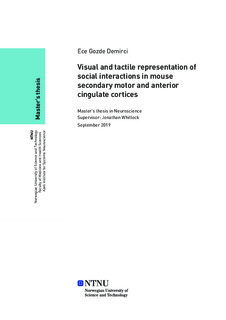| dc.description.abstract | Secondary motor (M2) and anterior cingulate (ACC) cortices are frontal association areas in the rodent brain that receive substantial information from several primary and associative areas, including visual and posterior parietal cortices. Rodent M2 is thought to be homologous to monkey premotor, supplementary motor and frontal eye areas, and is associated with self-initiated action and whisker movements.
The anterior cingulate cortex in rodents, on the other hand, is strongly associated with pain architecture and observational fear learning. Evidence suggests that ACC in rats exhibits mirror neuron-like activation for observed and experienced pain, and that it is critical for vicarious fear learning in rats and mice. However, much less is known of rodent ACC function in the context of prosocial behaviour, even though human and monkey studies suggest the ACC is important for social cognition, including emotional regulation in a social context and during positive social interactions.
Rodents also rely heavily on tactile information, especially via whisking behaviour, to sense objects in the world and each other. In both mice and rats, physical touch with a conspecific facilitates social buffering of pain, consolation, and it has been shown to have anxiolytic effects. Both M2 and ACC are therefore likely to play important roles for tactile processing and are suitable candidates for social cognition research.
Therefore, we wished to determine if voluntary physical interaction with a conspecific drove preferential activity in M2 or ACC compared to interactions that did not allow tactile interaction. To do this we used fluorescence in situ hybridization (FISH) against the immediate early gene Arc to compare activity patterns of neural ensembles across two behavioural epochs of social interaction with a conspecific. One of the epochs allowed voluntary physical interaction while the second epoch was confined to visual observation.
We hypothesized that tactile versus visual interactions would lead to differentiated representations in both M2 and ACC, and this activity shift would be reflected in the distributed pattern of Arc signal. Our results, however, did not match this prediction. Rather, the data suggested that M2 and ACC respond to both types of social interaction with a general elevation in activity instead of separate ensembles. These results are consistent with a general role of these areas in processing social interactions regardless of whether the signals involved are only visual or include direct physical contact. | |
